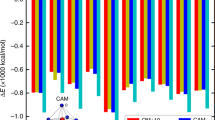Abstract
The main ideas of an electron-conformational (EC) model of ligand-activated ryanodine channels (RyR) that reduces many degrees of freedom of this gigantic nanoscopic molecular complex to two so-called electron and conformational degrees of freedom are presented. In the toy model, the conformational potential or energy profile of the RyR channel represents two branches that describe the dependence of energy on the conformational coordinate (reaction coordinate) in the initial and ligand-activated states, respectively. A model extension that takes into account both the tetrameric structure of the RyR channel and additional (orthogonal) rotational conformational mode has been considered. The EC model has been demonstrated to give a biophysical basis to the traditional phenomenological model of Markov chains. To demonstrate the possibilities of the EC model, we refer to examples of model description of the dynamics of isolated RyR channels and clusters of RyR channels in release units of the heart cell.








Similar content being viewed by others
REFERENCES
D. M. Bers, Nature 415, 198 (2002).
S. Györke and C. Carnes, Pharmacol. Ther. 119, 340 (2008).
W. Peng, H. Shen, J. Wu, W. Guo, X. Pan, R. Wang, S. R. Wayne Chen, and N. Yan, Science 354, 301 (2016). doi 10.1126/science.aah5324
E. Saftenku, A. J. Williams, and R. Sitsapesan, Biophys. J. 80, 2727 (2001).
S. Mukherjee, N. Lowri Thomas, and A. J. Williams, J. Gen. Physiol. 140, 139 (2012).
A. S. Moskvin, M. P. Philipiev, O. E. Solovyova, and V. S. Markhasin, Dokl. Biochem. Biophys 400, 32 (2005).
A. S. Moskvin, M. P. Philipiev, O. E. Solovyova, and V. S. Markhasin, J. Phys: Conf. Ser. 21, 195 (2005).
A. S. Moskvin, M. P. Philipiev, O. E. Solovyova, P. Kohl, and V. S. Markhasin, Prog. Biophys. Mol. Biol. 90, 88 (2006).
M. P. Philipiev, Candidate’s Dissertation in Mathematics and Physics (Ural State Univ., Yekaterinburg, 2007).
A. S. Moskvin, A. M. Ryvkin, O. E. Solovyova, and V. S. Markhasin, JETP Lett. 93, 403 (2011).
A. S. Moskvin, A. M. Ryvkin, O. E. Solovyova, and V. S. Markhasin, Dokl. Biol. Sci. 444, 162 (2012).
A. M. Ryvkin, Candidate’s Dissertation in Mathematics and Physics (Pushchino, 2014).
W. Bialek and R. F. Goldstein, Phys. Scr. 34, 273 (1986).
W. G. Noid, J. Chem. Phys. 139, 090901 (2013).
T. Ha-Duong, in Protein Conformational Dynamics, Ed. by K.-L. Han, X. Zhang, and M.-J. Yang (Springer, 2014), p. 157.
A. Rubin, Biophysics, Vol. 1: Theoretical Bophysics (Vysshaya Shkola, Moscow, 1987).
D. J. Wales, J. Chem. Phys. 142, 130901 (2015).
A. A. Rauscher, Z. Simon, G. J. Szöllösi, L. Gräf, I. Derenyi, and A. Malnasi-Csizmadia, FASEB J. 25, 2804 (2011).
W. T. Coffey and Yu. P. Kalmykov, The Langevin Equation, 3rd ed. (World Scientific, 2012).
A. Vaziri and M. B. Plenio, New J. Phys. 12, 085001 (2010).
C. C. Chancey, S. A. George, and P. J. Marshall, J. Biol. Phys. 18, 307 (1992).
R. Sitsapesan and A. J. Williams, J. Membr. Biol. 137, 215 (1994).
R. Sitsapesan and A. J. Williams, J. Membr. Biol. 159, 179 (1997).
H. Kermode, A. J. Williams, and R. Sitsapesan, Biophys. J. 74, 1296 (1998).
B. Tencerova, A. Zahradnikova, J. Gaburjakova, and M. Gaburjakova, J. Gen. Physiol. 140, 93 (2012).
A. S. Moskvin, B. I. Iaparov, A. M. Ryvkin, O. E. Solovyova, and V. S. Markhasin, JETP Lett. 102, 62 (2015).
A. S. Moskvin, B. I. Iaparov, A. M. Ryvkin, and O. E. Solovyova, Biophysics 61, 614 (2016).
A. M. Ryvkin, N. M. Zorin, A. S. Moskvin, O. E. Solovyova, and V. S. Markhasin, Biophysics 60, 946 (2015).
ACKNOWLEDGMENTS
The author is grateful to M.P. Filip’ev, O.E. Solov’eva, A. M. Ryvkin, N. M. Zorin, and B. Ya. Yaparov for fruitful cooperation and to R. Sitsapesan, K. Witschas, A. Zahradnikova, and I. Zahradnik for useful discussions.
The study was supported by the Program 211 of the Government of the Russian Federation, agreement no. 02.A03.21.0006, and projects nos. 2277 and 5719 of the Ministry of Education and Science of the Russian Federation.
Author information
Authors and Affiliations
Corresponding author
Additional information
Translated by E. Berezhnaya
Rights and permissions
About this article
Cite this article
Moskvin, A.S. The Electron-Conformational Model of Ryanodine Receptors of the Heart Cell. Tech. Phys. 63, 1277–1287 (2018). https://doi.org/10.1134/S1063784218090128
Received:
Published:
Issue Date:
DOI: https://doi.org/10.1134/S1063784218090128




